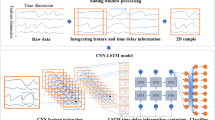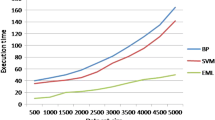Abstract
With strong feature extraction ability, neural networks can effectively realize rolling bearing fault diagnosis. However, due to the impact of noise and variable working conditions in the bearing environment, it is difficult to extract important fault feature information from vibration signals. Aiming at the above problems, a fault diagnosis method for improved residual shrinkage network of rolling bearings is proposed in this paper. In this method, the vibration signal of rolling bearing is taken as model input. Firstly, the initial features of the signal are extracted by the preprocessing module. Then, the threshold and slope factors are designed to improve the soft threshold function, and the subdomain network is constructed to adaptively determine the parameter according to different characteristics to suppress the noise interference. Secondly, a two-pool structure is introduced to improve the weighting of important features by the attention mechanism, which enhances the generalization performance of the model. Finally, multi-layer improved residual shrinkage blocks are used to reduce the noise impact and enhance the fault feature information, so as to improve the accuracy of multi-classification fault identification. The experimental results show that the accuracy of the proposed method is 99.83% and the standard deviation is 0.83, both of which are higher than other existing neural network methods. It proves that the proposed method has a strong advantage in the information extraction of rolling bearing fault features.












Similar content being viewed by others
References
Sun Y, Wang J, Wang X (2023) Fault diagnosis of mechanical equipment in high energy consumption industries in China: a review. Mech Syst Signal Process 186:109833
Kruczek P, Zimroz R, Wyłomańska A (2020) How to detect the cyclostationarity in heavy-tailed distributed signals. Signal Process 172:107514
Wang S, Niu PJ, Guo YF et al (2021) Bearing fault diagnosis based on adaptive piecewise hybrid system. J Aerodyn 36(10):2090–2100
Zhen JD, Pan HY, Cheng JS et al (2020) Mechanical fault diagnosis method based on adaptive empirical Fourier decomposition. J Mech Eng 56(09):125–136
Zhang K, Xu YG, Ma CY et al (2020) Empirical fast kurtogram and its application in rolling bearing fault diagnosis. J Vib Eng 33(03):636–642
Li ZN, Liu YU, Hu ZF et al (2021) Empirical wavelet transform-synchro extracting transform and its applications in fault diagnosis of rolling bearing. J Vib Eng 34(06):1284–1292
Yu ZF, Xiong BS, Li XM et al (2022) Fault diagnosis of helicopter rolling bearing based on improved SqueezeNet. J Aerodyn 37(06):1162–1170
Zhao M, Zhong S, Fu X et al (2020) Deep residual shrinkage networks for fault diagnosis. IEEE Trans Ind Inf 16(7):4681–4690
Chen XL, Sun YF, Li C et al (2022) Stable anti⁃noise fault diagnosis of rolling bearing based on CNN⁃BiLSTM. J Jilin Univ (Engineering Edition) 52(02):296–309
Zhang T, Liu S, Wei Y et al (2021) A novel feature adaptive extraction method based on deep learning for bearing fault diagnosis. Measurement 185:110030
Tang J, Wu J, Qing J (2022) A feature learning method for rotating machinery fault diagnosis via mixed pooling deep belief network and wavelet transform. Results Phys 39:105781
Chen BJ, Chen XL, Shen BM et al (2021) An application of convolution neural network and long short-term memory in rolling bearing fault diagnosis. J Xi’an Jiaotong Univ 55(06):28–36
Wang R, Jiang H, Zhu K et al (2022) A deep feature enhanced reinforcement learning method for rolling bearing fault diagnosis. Adv Eng Inform 54:101750
Ding Y, Jia M, Miao Q et al (2022) A novel time–frequency transformer based on self–attention mechanism and its application in fault diagnosis of rolling bearings. Mech Syst Signal Process 168:108616
Chen Y, Dai X, Liu M, et al. Dynamic relu. In: European conference on computer vision. Springer, Cham, 2020: 351–367
Dixit S, Verma NK, Ghosh AK (2021) Intelligent fault diagnosis of rotary machines: conditional auxiliary classifier GAN coupled with meta learning using limited data. IEEE Trans Instrum Meas 70:3517811. https://doi.org/10.1109/TIM.2021.3082264
Su H, Xiang L, Hu A et al (2022) A novel method based on meta-learning for bearing fault diagnosis with small sample learning under different working conditions. Mech Syst Signal Process 169:108765
Zhang Z, Chen L, Zhang C et al (2022) GMA-DRSNs: a novel fault diagnosis method with global multi-attention deep residual shrinkage networks. Measurement 196:111203
Li Y, Gao Q, Miao B et al (2021) Application of the refined multiscale permutation entropy method to fault detection of rolling bearing. J Braz Soc Mech Sci Eng 43(5):280
Smith WA, Randall RB (2015) Rolling element bearing diagnostics using the Case Western Reserve University data: a benchmark study. Mech Syst Signal Process 64–65:100–131
Zhang Y, Zhu D, Zhao L (2021) Fault diagnosis of rolling element bearing using ACYCBD based cross correlation spectrum. J Braz Soc Mech Sci Eng 43:1–18
Author information
Authors and Affiliations
Corresponding author
Ethics declarations
Conflict of interest
The authors declare that they have no known competing financial interests or personal relationships that could have appeared to influence the work reported in this paper.
Additional information
Technical Editor: Jarir Mahfoud.
Publisher's Note
Springer Nature remains neutral with regard to jurisdictional claims in published maps and institutional affiliations.
Rights and permissions
Springer Nature or its licensor (e.g. a society or other partner) holds exclusive rights to this article under a publishing agreement with the author(s) or other rightsholder(s); author self-archiving of the accepted manuscript version of this article is solely governed by the terms of such publishing agreement and applicable law.
About this article
Cite this article
Wang, L., Zou, T., Cai, K. et al. Rolling bearing fault diagnosis method based on improved residual shrinkage network. J Braz. Soc. Mech. Sci. Eng. 46, 172 (2024). https://doi.org/10.1007/s40430-024-04729-w
Received:
Accepted:
Published:
DOI: https://doi.org/10.1007/s40430-024-04729-w




